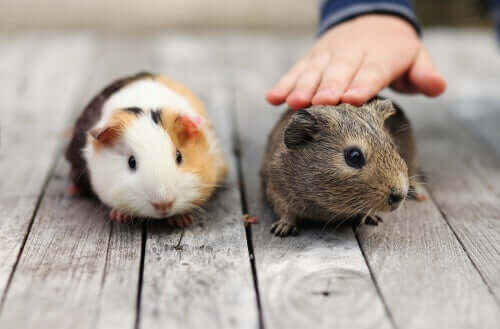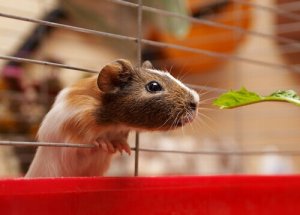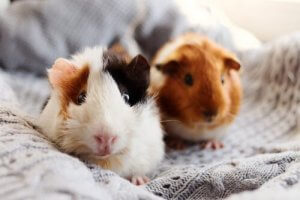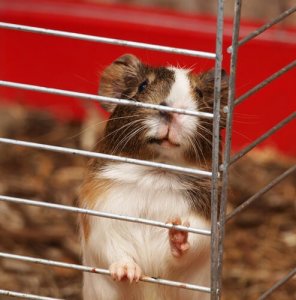Domestic Guinea Pig Care: 5 Common Mistakes

Commonly known as the guinea pig, the domestic guinea pig, or the cavy, these cute little rodents are really easy to look after, making them the ideal pet for young children.
However, just because they are easy to look after, doesn’t mean these animals don’t require a great deal of time and attention. In fact, when it comes to caring for your guinea pig, there are several important factors you need to keep in mind. By avoiding certain common mistakes, you can make sure your domestic guinea pig lives a long and happy life.
Domestic guinea pig care: only feeding pelleted foods
Many people make the mistake of thinking that guinea pigs can live on a diet of store-bought pellets. Although pelleted foods aren’t necessarily bad for them, they should only really make up a small percentage of their diet.
Guinea pigs are herbivores, and as such, the majority of their diet should be made up of hay. In fact, experts recommend that hay should represent approximately 75% of their daily food intake. Fresh, leafy vegetables are also important – feeding them small pieces of fruit and veg is a great way to enrich their diet.

Pelleted food should only make up about 5 – 10% of a rodent’s diet. Pay close attention to the portion sizes – avoiding obesity is one of the best ways to keep your guinea pigs happy and healthy.
Sugary fruits
Fruit is the perfect treat for rodents, and will make a great addition to your guinea pig’s diet. However, it’s important to choose your fruits carefully. Those that are high in fructose should be avoided.
It’s best to go for fruits that are low in calories. We would recommend fruits such as pineapple, apple, kiwi, pear, and watermelon. You can feed them small pieces throughout the week as part of a healthy, balanced diet.
Paying close attention to their diet is actually one of the best ways to keep your guinea pigs healthy, and it’s important not to let them become overweight. Fruits that are rich in fiber and fatty acids are not recommended.
Common mistakes: only having one guinea pig
This is one of the most common mistakes of all. Many people believe that guinea pigs can quite happily live alone, when they are in fact highly sociable animals.

As such, you really need to buy at least two guinea pigs. That way, they can socialize with one another, and won’t feel lonely. Watching them interact and seeing their true personalities shine through is a great experience for young children.
If their cage is clean, well-ventilated, and spacious, having two guinea pigs isn’t all that different from having one. Plus, having a playmate will also encourage your pets to stay active.
Buying too small a cage
If you buy a guinea pig from the pet store, it’s likely to still be a baby. As a result, it’s very easy to make the mistake of buying a small cage, in proportion with the size of your new pet. If the pet store is only interested in making money, they’ll have no problem letting you buy a cage that will quickly become too small for your pet.

However, it’s likely that your guinea pig will continue to grow, and, as such, will soon need more space. It goes without saying that you should never keep an animal in a cage where it doesn’t have enough space to move around comfortably. Whether store-bought or homemade, your guinea pig’s cage needs to be large and spacious.
Too small a cage can prevent your pet from getting enough physical exercise, which can quickly lead to weight gain. Not to mention the emotional and psychological effects lack of space can have on your pet. Male rodents, in particular, need lots of space and mental stimulation.
Using paper for bedding
An important part of a guinea pig’s habitat is its sleeping space. Although people often use wood shavings, it’s important to choose carefully. Wood such as pine often contains substances which, if inhaled regularly, can be harmful to your guinea pig’s health.
Another common mistake is to line their bed with paper, which can quickly start to smell. Many people recommend giving guinea pigs woolen beds. They are comfortable, and really easy to clean. In fact, this is one of the cheapest and environmentally-friendly options.
When all’s said and done, looking after guinea pigs is fairly simple. Obesity is the biggest issue you can face. But with a little knowledge and planning, you’ll be able to keep your pets happy and healthy for years to come.
All cited sources were thoroughly reviewed by our team to ensure their quality, reliability, currency, and validity. The bibliography of this article was considered reliable and of academic or scientific accuracy.
- Abrilveterinarios.es. Cobayas, atención y cuidados. Extraído de: http://www.abrilveterinarios.es/descargas/categoria37/cuidados-cobaya.pdf
- Cvmadagascar.com.2015. Cuidados y mantenimiento de cobayas. Extraído de: http://cvmadagascar.com/wp-content/uploads/2015/12/CUIDADOS-Y-MANTENIMIENTO-DE-COBAYAS.pdf
